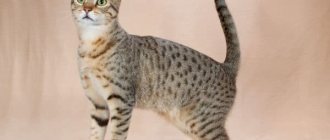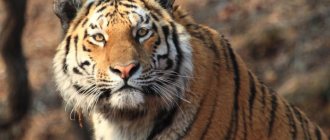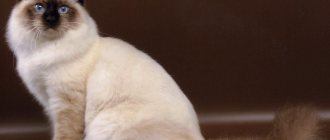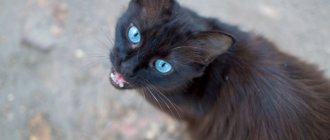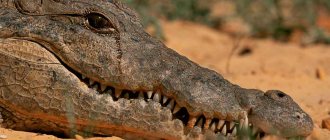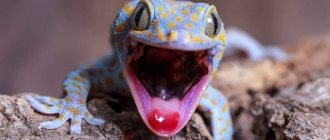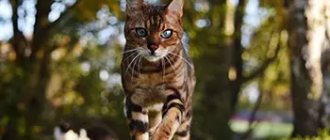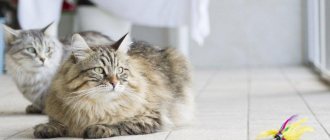When purchasing a pet, future owners most often make a choice based on the external characteristics of the breed, its popularity and level of pedigree. But the character and temperament of the cat is essential. Indeed, for many, the absence of aggression, the pet’s sociability and human orientation will be important.
When getting a cat as a pet, many owners want to see a loyal, affectionate and kind pet next to them. Below we describe exactly those cat breeds that have these character traits.
Ragdoll
The name of these cats is translated as “rag doll”. This is due to the fact that in the hands of the owners the cat completely relaxes, and there is a feeling as if in the hands of a toy, and not a living creature. The character of Ragdolls is just as soft: they have absolutely no aggression, these cats are attached to all family members, not singling out anyone more than the rest. They love to sit in your arms, they are affectionate and trusting. It is very important to communicate and pay attention to such a pet every day, since they suffer greatly from loneliness.
Sphinx
The mystical appearance of sphinxes leaves no one indifferent: some are perplexed as to how a strange bald creature could end up in the feline family, others sincerely admire their unusual beauty. Be that as it may, experts of the breed claim that once you get to know such a cat closer, you can no longer live without him. Many sphinxes protest when they are grabbed, but they happily sit on their laps and accompany their owners everywhere, for which they are called “Velcro.” They are extremely curious, very active and often put on a fun acrobatic show for the whole family.
Exotic shorthair
These cats with short, plush fur and large eyes are very friendly and simply love to be in the company of their owners. They get along well with all family members. But the truth is, if new people or pets appear, these cute cats will take some time to accept them.
Despite his disposition towards all family members, an exotic usually singles out one person for himself, who will become the main one for him. It is to him that he will show his devotion and loyalty. These cute cats absolutely cannot stand loneliness, and are ready to accompany their owner on any trips and travels.
Difficulty in care
Every cat requires grooming, but some breeds require more or less attention. Difficulty in content can both depress and delight - consider your desires and capabilities.
Cats that do not require special care
If you don’t want to spend your evenings combing wool or thinking about your pet’s menu, pay attention to the following breeds:
Abyssinian cat
Short fur and sparse shedding
Bombay cat
Cat for lovers of black clothes
Egyptian Mau
Easy to care and maintain
Cornish Rex
Enough to feed and pet
Oriental cat
Almost no shedding
Siamese cat
Suitable for even the laziest owner
This is an abbreviated list, but the easiest cats to care for are short-haired cats with no quirks in appearance.
Long-haired cats often shed and require careful grooming, while hairless cats get cold and sweat. Pets with short hair are an excellent choice for a busy owner.
Difficult breeds to keep
Are you a passionate cat lover and ready to devote a considerable amount of time to caring for your pet? Then take a closer look at these breeds:
Don Sphynx
In winter it will never leave the battery
Canadian Sphynx
Freezes in the cold, sweats in the heat
Maine Coon
A big cat has more fur
Persian cat
Thick fur sheds heavily
Ragdoll
Lazy and fluffy
Scottish lop-eared
Curled ears need to be cleaned regularly.
Sphinxes are cold cats that want constant warmth and care. The Persian cat is complex due to its record length of fur, which constantly gets tangled into tangles. In addition, Persians have a flat face, which can cause them to get sick often.
It is not easy to care for cats with unusual ears: Scottish Fold or American Curls. Also, all long-haired breeds can be considered difficult-to-care cats.
Manx
These amazing tailless cats love to be the center of attention. They are sociable, interact well with children and love playing together. Manx cats are great for large families because they love everyone in the family and try to please them.
Manx cats are distinguished by a calm and friendly character, obedient and unpretentious, and easily adapt to changing conditions. Manx treat children well, they are careful when playing with them and practically do not let out their claws.
Snow shu
Magnificent, but still quite rare representatives of the Snowshoe breed, which literally translates as “snow slipper,” have won the recognition of many animal lovers. Cute cats with white paws embody all the qualities of a truly domestic and affectionate cat.
Snowshu are very attached to their owner, and subtly sense his mood. If the owner is sad, the cat will try to calm him down by purring and caressing him. Well, if he is in a good mood, he will take measures to involve him in joint games.
Snowshoes are very smart, highly intelligent and well trained in commands and tricks. Representatives of the breed interact well with children and also get along well with other types of pets.
Russian blue
Cats of this breed are distinguished by their quiet disposition: they almost never meow loudly. The character is calm and calm, and the cats are also quite independent. That is why, despite their warm affection for their owners, they can quite easily be alone at home.
These cats get along well with children. But if the child bothers her for a long time, he will try to hide from him in some secluded place.
Cats get along well with other pets in the house. But friendship with decorative rodents will not work, since cats of this breed have especially strong hunting instincts. So, according to the Russian Blue cat, there is absolutely no place for rodents, wild and domestic, in the house and on the property.
Character, behavioral characteristics and habits
Affectionate and devoted cats bring more positive emotions into the life of their owner. Therefore, for those who are just planning to choose a future family pet, we suggest focusing on factors that will tell you about the cat’s character:
- Color. No matter how strange it may sound, behavior can be predicted even by the color of the coat. British scientists have identified a pattern. They interviewed breeders and doctors about the connection between character and color. It turned out that the majority of respondents consider pure white cats to be capricious, those who like to show off their significant position. They know their worth, are easily offended over trifles and do not accept affection in this state. But blacks, on the contrary: they are friendly, they can cope with stress themselves and help their person cope with it. Silver and golden cats are relatively calm, but become very nervous in unusual situations. The most inflexible ones are multi-colored. Most owners noted their problems with the toilet, aggressive behavior in the house and at the doctor.
- Body type. This opinion is not supported by research, but is also based on the answers of experienced breeders: thin animals have an unstable psyche, therefore they are often capricious and unfriendly, but massive animals with heavy bones are often docile and friendly.
- Upbringing. Pets that go through a difficult childhood become “wild”: they had many brothers and sisters stronger than they were, they were hurt by their first owners, or they grew up on the street. It's hard to influence when the cat is already an adult, but you can change this if you adopt a kitten!
- Muzzle expression. This is a logical conclusion from the previous point, which is confirmed by the director of a company that helps homeless animals in the USA. Your pet's hormones affect not only behavior, but also the growth and shape of the body's bones. Therefore, there is a direct connection between the features of a cat’s face and the characteristics of its character.
The kindest cats are often black or silver.
Even the most affectionate cats will be wary of their new owner at first. Only after some time will you be able to see the characteristic manifestations of goodness:
- looks into the eyes, squinting a little and purring;
- allows himself to be stroked and exposes his stomach;
- rubs its muzzle, and then its whole body, against the leg, furniture, and clothes of the owner;
- licks a person’s face or hair - it means she considers herself a protector and thus takes care of you.
Burmanskaya
These cats are distinguished by their combination of amazingly beautiful appearance and excellent character. And it’s not for nothing that this is one of the most popular cat breeds in the world. Burmese are ready to participate in all family affairs, sociable and friendly. The breed's characteristic feature is the almost complete absence of aggression, so the pets get along with animals of other species.
Burmese are completely calm towards children and are ready to tolerate pranks and willingly play with them. They prefer active and active games. But after playing hide and seek or catching up, the Burmese will happily sleep in the arms of its owner. The Burmese cat is people-oriented, so it is very difficult to tolerate loneliness.
Neva Masquerade
Amazingly beautiful cats with fluffy fur and blue eyes are distinguished by excellent health, flexible character and extraordinary intelligence. They communicate with people as equals and express emotions with their voice. Their refined manners are worthy of admiration: they are graceful, extremely delicate and unobtrusive, although they are not averse to running and playing. Perhaps, Neva Masquerade cats take first place in the ranking of “The kindest cat breeds for children.” An adult cat would rather tolerate annoying petting than scratch or bite a child. In extreme cases, he will simply turn around and run away. Nevaks are also born empaths: when the owner is in pain or has a hard time at heart, they come to pity and reassure with a quiet melodious meow.
Siberian cat
Siberian cats are distinguished by their large size, luxurious coat and independent disposition. But for all their independence and desire for freedom, they are very affectionate and friendly towards children. They love games with a ball and mice, they are very active and sociable. They usually find a common language with other pets, unless, of course, they themselves show aggression.
“Siberians” can sometimes be prone to a bad mood, in which case they simply seek privacy and do not make contact. Fortunately, this happens infrequently, but still, during such periods it is better not to bother the cat with your attention. But the owner is not in the mood, or he is busy with something, the cat seems to feel this, and will never impose itself.
Rating of the smartest cat breeds
| Nomination | place | breed | rating |
| The smartest breeds of shorthair cats | 1 | Abyssinian cat | 5.0 |
| 2 | Oriental cat | 4.9 | |
| 3 | British cat | 4.8 | |
| 4 | Siamese cat | 4.7 | |
| 5 | Bengal cat | 4.6 | |
| The smartest breeds of semi-longhair cats | 1 | Norwegian Forest Cat | 5.0 |
| 2 | Maine Coon | 4.9 | |
| 3 | Balinese cat | 4.8 | |
| The smartest breeds of long-haired cats | 1 | Siberian cat | 5.0 |
| 2 | Turkish Angora | 4.9 | |
| 3 | Munchkin | 4.8 | |
| 4 | Russian blue | 4.7 | |
| The smartest breeds of hairless cats | 1 | Canadian Sphynx | 5.0 |
| 2 | Ukrainian Levkoy | 4.9 | |
| 3 | Minskin | 4.8 | |
| 4 | Peterbald | 4.7 |
Japanese Bobtail
Japanese bobtails are completely unsuitable for the role of a “couch” cat. They are very energetic, curious and inquisitive, and are also known for their amazing jumping ability. These are fidgety and passionate hunters, which is something their owners need to remember. After all, even on a balcony or window, hunting for a fly, they completely forget about everything and can accidentally jump out, getting injured.
Bobtails do not like strangers and do not make contact, but in their family they are very affectionate and sociable. Japanese bobtails need to be provided with physical exercise, otherwise, if their ebullient energy does not find a way out, the cats may show nervousness and unusual aggression.
Oriental cat
These are very active and active pets. Many owners even compare them to dogs. They are very loyal, love to follow their owner everywhere and do not tolerate loneliness at all. They are distinguished by increased talkativeness, so they try to interact and communicate with their owners.
Orientals have an energetic temperament and are always ready for active games. Cats of this breed rarely show their claws, and they also love children, so they can be excellent play partners for them. Another plus is that Orientals are excellent at learning various tricks and commands.
Scottish fold
The Scottish Fold or Scottish Fold has an excellent understanding of human behavior. You can’t trick them around your finger – cats know very well where especially tasty treats and toys are. Their love of puzzle toys allows them to learn to think outside the box. Scottish Folds grasp everything on the fly: they are easily given simple tricks and dog commands.
Did you know that for the first time a Scottish Fold cat was shown in the role of Matilda, Freken Bock’s favorite, in the cartoon “The Kid and Carlson”?
According to animal psychologists, the Scottish Fold breed has excellent memory. They are easily brought up and accustomed to “human” etiquette. Their intelligence is sometimes amazing, so cleverly do cats manipulate people.
Abyssinian
These beautiful “sunny” cats have an independent character, they are inquisitive, active and playful. They are very attached to a person, they love everyone in the family, but there will definitely be a person who is most beloved, the most important person for the cat.
It is to him that the cat is more attached than others, and will miss him in case of separation. Abyssinians love to be petted. They often cuddle up to their owners, purr loudly and lightly bite their hands, thus expressing their love and affection.
They, like dogs, run to meet their owner from work. And then they will relentlessly follow him, like a shadow, so as not to lose him from sight. They love to sleep in bed, that is, they are ready to be close to you even at night.
Maine Coon
According to reviews from Maine Coon breeders, their pets are very similar in character to dogs. These large cats are very friendly and good-natured. By temperament, coons, as breeders lovingly call them, are very calm animals, moderately sociable.
They will never impose themselves, and they themselves will not tolerate a familiar attitude. Cats will never allow themselves to be squeezed or kneaded, although they respond positively to soft stroking. They also love active games, which they prefer to alternate with rest at the feet of the owner.
Many Maine Coons have an amazing passion for water, love to swim, play with the stream of water from the faucet, and some even manage to create fun entertainment in their water bowl.
Scottish lop-eared
Scottish Fold cats are popular all over the world. To a large extent, this is due not only to her cute appearance, but also to her balanced temperament. Representatives of this breed are noble, intelligent and quick-witted. They have self-esteem and consider themselves absolutely equal members of the family.
These cats are sensitive, have a particularly hard time with loneliness, and can even become depressed. Therefore, breeders do not recommend keeping them for people who are away from home for a long time.
Fold-eared cats are great for families with children, since they will never fight off a pestering baby with their claws, but will only try to go to a place inaccessible to him.
Criteria for assessing cat intelligence
If it is easy to assess the level of human intelligence using an IQ test, then with cats the situation is much more complicated. Scientists have to simulate situations, observe the reaction of an animal in certain circumstances, compare the behavior of the subject with the behavior of his relative in the same conditions, and draw appropriate conclusions. The main evaluation criteria are:
- socialization - the ability to adhere to certain rules of behavior (do not relieve yourself in the wrong place, do not steal food from the table, do not sharpen your claws on the sofa or wallpaper, etc.), an adequate reaction when interacting with a person, the absence of unreasonable aggression;
- memory - the ability to identify the owner’s voice, remember the nickname, etc.;
- ingenuity - the ability to find a way out in extreme situations, quickly adapt to new conditions;
- sociability - the ability to find a common language with other animals, contact people, express your preferences or dislikes;
- intelligence - the ability to solve puzzles, solve simple problems, speed of learning simple commands.
Research Features
At different times, animal psychologists conducted experiments in one specific area. For example, Japanese scientists have found that a cat accurately recognizes the owner’s voice among dozens of other voices. However, unlike a dog, she is in no hurry to run towards him: on the contrary, she can pretend that she does not hear her owner calling her at all. Researcher Atsuko Seiko, one of the curators of the experiment, explained this behavior by the fact that cats, in the process of evolution, have learned to hide feelings from others in order to survive.
Cats have better developed sensorimotor intelligence. This means that they are more sensitive, more accurate in their movements and are able to hunt very large game (relative to their own size, of course). A lynx is much more likely to catch a hare than a wolf or fox.
Dogs have better social intelligence than cats.
Canines hunt in packs: they need to be able to communicate more accurately than cats. Their hunting method, involving dozens of individuals, is striking in the distribution of roles. It’s easier for people to understand dogs, and dogs understand people much better than cats. Human intelligence is also social. Ilya Kolmanovsky, head of the biology laboratory of the Polytechnic Museum thequestion.ru/questions/713/kto-umnee-koshki-ili-sobaki
British biologist John Bradshaw, author of the best-selling book Cat Sense (known in Russian as “The Secret Life of a Cat. How to Understand the True Nature of a Pet and Become Its Best Friend”), came to the conclusion that a cat perceives its owner as its big but stupid relative . Seeing how generously he spends on her pleasures, she easily manipulates him, but considers herself smarter.
John Bradshaw's book Cat Sense will become a reference book for the owner who wants to better understand his pet
At the same time, the pet becomes very attached to its owner, associating him with his mother cat all his life, communicating with him through meowing. The range of sound signals produced depends on the emotional state of the animal. For example, a loud and persistent “meow” indicates that the cat demands something or is dissatisfied with something, and a monotonous purr indicates relaxation and tranquility.
It is noteworthy that cats never communicate with each other through meowing - this “language” is designed specifically for communication between animals and humans.
Since the criteria used to study the behavior of baleen-tailed cats were quite subjective, none of the researchers tried to find out which of the cat breeds is the smartest, and which nature has not endowed with special intelligence. For the first time, the subsidiary channel of the American Discovery, Animal Planet, was engaged in such a classification. At the end of the experiments, based on the data obtained, the animals were given marks on a 10-point scale.
Table: ranking of the smartest cats according to Animal Planet
| Number of points scored | Breed |
| 10 | sphinx |
| 9 |
|
| 8 |
|
| 7 |
|
| 6 |
|
| 4 | Persian |
| 3 |
|
Youth versus old age
In the course of research, it turned out that cats of ancient breeds (Sphinxes, Siamese, etc.) are distinguished by the most outstanding intellectual abilities. This happened as a result of natural selection. The fact is that all the mental activity of predatory animals is aimed at searching and capturing prey, therefore their brain is better developed than that of herbivores. In order to feed themselves and their offspring, and protect themselves from enemies, cats had to show remarkable ingenuity. Over the years, these skills were honed and improved, and the intellect developed. The weakest and most unadapted individuals weeded out on their own. Representatives of the most ancient breeds that have survived to this day have outstanding mental abilities and savvy at the genetic level.
For the same reason, a high level of intelligence is observed in outbred cats living on the street. They train their brains every day, facing difficulties and dangers, trying to defend their place in the sun. Well-fed and lazy pets at this time rest calmly on the sofa, knowing that the owner will take care of them. If you want to get a smart and quick-witted pet, unlock its potential with games, puzzles, and training. Proper preparation and constant practice will definitely bring positive results.
Representatives of young, recently bred breeds (for example, exotic shorthair, Selkirk Rex, etc.) are not particularly intelligent and quick-witted. This fact is explained by the fact that breeders think more about the original attractive appearance of the animal, its good health, and the absence of hereditary diseases, rather than about the intellectual component. Such pets are more likely to decorate the home than full family members or devoted friends.
Burmese cat
Burma is a cat that cannot stand being treated indifferently and has a hard time experiencing loneliness. These cats are very affectionate and obedient, and have aristocratic habits. These are playful and friendly pets, quick-witted and intelligent.
If there are other animals in the house, the Burmese will easily find a common language with them. But it is important to evenly distribute affection and attention between all pets, since these cats often show jealousy. They can also sometimes be intrusive and demand attention if they think that right now they lack it so much. They show strong affection for their owner and suffer from long-term loneliness.
European Shorthair
The second name of this breed is the Celtic cat. They are sociable animals, but can be shy in new environments. These cats are calm and good-natured and do not require much attention. They can calmly remain alone for a while, but at the same time they love their owner very much. “Europeans” are distinguished by their intelligence and curiosity. They never show aggression towards people, they also treat children well, and especially love playing and running around with them.
At what age is it better to adopt a cat?
An adult cat or a cute baby? This seems like a minor issue, but age is an important factor.
Kitty
As a rule, kittens are taken into the house. It is believed that in childhood the animal gets used to the new environment better.
Attention! The kitten must be at least three months old.
A cat feeds its cubs with milk until they are three months old. This is important because the baby acquires primary immunity. It is the mother who takes best care of health and knows what her “child” needs. Communication with the parent is also responsible for socialization. An early break with a nursing female is fraught with the following problems for the offspring:
- mental disorders;
- behavioral disorders;
- weak immunity.
The mother accustoms the cubs to unfamiliar food, instills hygiene skills, shows how to use a tray and sharpen their claws.
Temporary immunity is transmitted to the kitten with milk.
Cats are vaccinated at 8 and 12 weeks (booster vaccination). Therefore, after 3 months the body is maximally protected from infections.
Adult
Animals older than a year are reluctant to be taken into an apartment due to prejudice. But veterinarians assure: often these are just myths that have no basis in reality.
Table 1. The most common misconceptions of future cat owners.
MythReality
| It is easier to train a kitten to the litter box | Adults quickly understand what is wanted from them. And if they are already toilet trained, they will not shit anywhere, with rare exceptions and for “good reasons” (stress, illness, etc.) |
| An adult cat will not accept a new owner | Animals that have experienced cold and hunger appreciate taking care of themselves. Kittens take everything for granted and are spoiled |
| The child needs a kitten | Adult cats are more tolerant of children. Many of them have the talent of a nanny and stoically endure the importunity of children. |
| The owners abandoned the cat because he behaved badly | An animal may be left without owners due to their death, relocation, birth of a child, or other “harmless” reasons. |
| If you take a kitten, it will grow up healthy | This is not a fact due to unformed immunity. Kittens are more prone to serious illnesses and suffer more severely from infections. |
Adult cats are often more comfortable than kittens
Munchkin
Munchkin is the intellectual of the cat world. They are distinguished by intelligence and high intelligence, thanks to which they are excellent learners. These cats are very sociable and patient, and these qualities help them get along with other cats and dogs living in the house. Munchkins are active and inquisitive, always trying to be in the center of events. Short-legged cats are characterized by an absolute lack of aggression; they are affectionate and good-natured pets.
Munchkins have a very cute feature - the manner of sitting on their hind legs in a “column” position. At these moments, these cats resemble bunnies or kangaroos. They are also kleptomaniac cats; they tend to steal small things, so it is better to hide valuable items from them.
Cornish Rex
A pet of this breed is perfect for those people who expect unconditional loyalty from a cat and that the pet will accompany them everywhere. These cats are human-oriented and simply cannot live without his company. They love to communicate with their owner, never show aggression and are very talkative. Cornish Rexes are very active pets; they love active games with running and jumping.
The kindest and most affectionate breeds
The character of a pet largely determines the situation in the house. Therefore, when choosing a breed, consider what factors can enhance the positive aspects of your and the cat’s character.
Below is a list of good breeds of cats and cats with photos and names:
Persian cat
Persian cats are calm and easy-going pets.
This breed has undergone long-term selective selection for external characteristics and the development of balanced behavior. This is a suitable pair for your baby if you want them to grow up together. In childhood, Persians are quite playful, in adolescence they happily accept petting, and in adulthood they begin to spend their time in a serene way. They are absolutely not vindictive, but, like all the cats in this top, they need the attention of their owner.
Persians have long, silky hair that requires proper care. The color is often shaded and smoky. With such a cat you will see the world in his calm gaze.
- Weight: 4-7 kg.
- Height: up to 30 cm.
Review from Alice in Irecommend:
“Since early childhood, I have admired these amazing breeds, their unusually affectionate and kind characters, sometimes mannered, sometimes playful, but always very loyal!”
Neva Masquerade
The Neva Masquerade breed is very friendly
She is friends with any animal companions, friendly with children, and emotionally attached to her owner. He never shows aggression and resolves his desires judiciously.
The Neva Masquerade is the result of crossing a Siberian and a Siamese cat. She has an unusual appearance: Siamese coloring, bright blue eyes, long hypoallergenic fur.
- Weight: 6-9 kg.
- Height: 25-40 cm.
Marina's review on Irecommend:
“He needs attention, so he loves it when I play with him. Favorite toys are with feathers. When you come home, he always runs to greet you and tells you how you spent your day. If you talk to him, he answers, and it’s funny that he adapts to my intonation and also changes his own.
In general, I liked this breed for its good manners, unobtrusiveness, intelligence and, of course, beauty. He has a wonderful character, the cat is non-aggressive, I would recommend him to a family with children, because... When playing with children, he does not release his claws. Neva Masquerade Dogs are one of the most hypoallergenic breeds. If you decide to get one, you need to take into account that this is a long-haired breed, so you must have a desire to take care of the fur.”
Ragdoll
Ragdoll - affectionate and kind to the owner.
This breed always purrs in response to the owner's attention. No matter how uncomfortable the cat may be, she purrs if you are nearby. And also Ragdoll will never release his claws during the game.
The peculiarity is that they do not know how to group, so the owner needs to be careful not to drop or allow the cat to the window.
Some representatives have tufts on their ears. The body is massive and the chest is wide. The coat of good ragdolls is often lilac, blue, chocolate and dark gray.
- Weight: 4-6 kg.
- Height: 30-40 cm.
Alina's review on Irecommend:
“Follows us everywhere we go: to the kitchen? Oh, and there's a little cook here. Taking a bath alone? Well, no, just with me, I’ll sit next to you, you need company. He often sleeps with us, often in his house, but he always comes in the morning. He loves to cuddle, run and rub his head against his face.”
Exotic
An exotic cat spends almost all of its time next to its owner.
The exotic cat does not like to move a lot, so it does not mind spending a long time in the owner’s arms. In addition, he is very attached to his person. But be prepared that he will behave warily with strangers, most likely, he will hide in the back room before the guests arrive.
The coat is short and can be of different colors, but this breed is easily recognized by its upturned nose and prominent cheeks.
- Weight: 4-7 kg.
- Height: 30 cm.
Julia's review on Irecommend:
“Exotic cats are something incredible. I have never seen such kind animals. She looks like a good-natured chubby guy, a simpleton and an absolute optimist. Exotics do not fight with other animals, do not provoke, do not rush, and never take revenge. Due to some massiveness and slight clumsiness, exotics play sparingly; they are unlikely to hang on curtains, although they will try out of curiosity. The cat is very gentle, loves affection and is always next to me when I am at home, and also greets me at the door when I come home from work. The purring mode, by the way, is constantly turned on, even if you just look at the cat, and she will notice it.”
Siamese cat
Siamese cats are gentle and caring.
This breed is so attached to people that some representatives try to repeat the movements of the owner in their lives. It’s strange, but it looks very cute when a cat chooses a child as its chosen one. In addition to being loyal, she will show curiosity and affection towards your baby.
The coat color is constant: a light area of the body with dark areas on the muzzle, tail, ends of the paws and ears.
- Weight: up to 7 kg.
- Height: 23-25 cm.
Nina's review on Irecommend:
“As soon as you pick him up, he purrs, sleeps only with me, constantly asks to be held and immediately curls up into a ball. They are loyal to the last to their owners and get wildly upset when you leave them for a long time.”
British shorthair cat
British cats even look kinder
Looks like a teddy bear (look at the photo!), which kids will definitely love. He is a patient and humble pet and will not be the first to enter into conflict. He loves to have his ears scratched and takes part in active games with pleasure. The Briton, like others from the top good breeds, is attached to the owner, so it follows him everywhere: he looks at the cooking, lounges on the sofa, and attracts attention when you are nearby.
They have a thick coat, as a reaction to English dampness. Color ranges from blue to tabby (spotted). The calling card of this breed is its large round eyes and thick cheeks.
- Weight: 3-6 kg.
- Height: 28-33 cm.
Lana's review on Irecommend:
“Brits are very intelligent animals and have a unique character. They are very affectionate and friendly, but before you achieve such an attitude towards yourself, you need to be patient and find an approach to them. As soon as you find the approach, I assure you, you will receive such love that you could not even imagine! By the way, while I’m writing this review, do you know what Marcel is doing at this moment? He sits on the computer chair with me, so I have to balance on the chair in order to share this place with my pet. He buried his nose in me and fell asleep.”
Russian blue cat
Russian Blue is an intelligent and understanding breed
This is a very loyal and understanding animal: it always follows its owner, sleeps next to it, and understands immediately what they want from it. Therefore, if you travel often or stay at work for a long time, your pet will be very worried. The purebred Russian Blue never lets out its claws on human actions, so it is perfect for a home with children.
The cat's fur is short, gray-blue in color and has a silvery tint. The body is graceful and tall, this is clearly visible from the neck and legs.
- Weight: 3-7 kg.
- Height: up to 25 cm.
Review by Anastasia on Irecommend:
“This is the first time I’ve met such a flexible, quiet, kind and patient character. Seriously, the description of the Russian Blue's character fits him 100%. The neighbor's cat and dogs came to us, but Yurik was peaceful with everyone. He doesn’t scream like a hysteric when he wants to eat, and doesn’t get it if he needs something. If you take it in your arms, it’s good, if you don’t take it, that’s fine. Such a cultured intellectual. True, he is afraid of strangers, especially emotional and noisy ones.”
Burmese cat
The Burmese cat is always kind and in a good mood
Smart and shy animal. The cat loves to show her positive qualities: she caresses her feet, calmly watches and follows people. On rare occasions you will find her in a bad mood.
The color of the short fur is often light and dark brown, sometimes red and purple.
- Weight: 3-6 kg.
- Height: 20-25 cm.
Victoria's review on Irecommend:
“I recommend this breed only to those who love clingy, obsessively affectionate cats. He will be your shadow, we often call ours – I AM EVERYWHERE. These animals are completely non-aggressive and do not scratch, which is very important when there are children in the house. When I was a kitten, I often played with children, no, not in cat games, like running after a string, etc., he ran with my children and played hide and seek. Burma is friendly with other pets, she can make almost anyone at home fall in love with her.”
Oriental
The Oriental breed is a mischievous but sophisticated look
The Oriental is an elegant, nimble, sophisticated cat. He is sociable, so he doesn't like to be left alone. At the same time, he is friendly, active and even a little hooligan, so he is perfect for a family with children.
The fur is short and lies close to the body. The color can be any color, up to 300 different shades. A distinctive feature of the breed is its large ears, which are set low and spaced apart.
- Weight: 2.5 – 4.5 kg.
- Height: 20-25 cm.
Tatyana's review on Irecommend:
“Good cat! This is one hundred percent! He is not vindictive, not capricious, he loves his household the way dogs do. He always greets you when you come home from work, faithfully waits for you and, of course, misses you very much. He loves to be stroked, scratched, squeezed, or anything at all, as long as they touch him and pay attention to him. He does not tolerate indifference; he will walk and meow and complain. He loves to play, I repeat VERY, VERY LOVES TO PLAY!!! Our big-eared cat is already 2 years old, and he’s like a kitten, it’s touching, and for that we can forgive him all his mischief.”
Maine Coon
Reasonable and family-oriented Maine Coon
His mood can range from active to tame. When he sees the owner, he responds with a friendly purr. The Maine Coon is distinguished by its intelligence among other breeds, and its calmness is more a reasonable behavior than a feature of the character itself. Therefore, this representative is more suitable for an adult, calm owner.
Outwardly it resembles a small lynx: long body, tufts on the ears, long hair, appropriate color.
- Weight: 4-8 kg.
- Height: up to 40 cm.
Margarita's review on Irecommend:
“This cat is space. Although this is an animal, its intellect is focused not just on communication, but on learning, games, and partnership. This is an example of courage and patience; he will give you hundreds of times more than you give him. But provided that you are ready to consider it, understand it, and devote time to it.”
Persian cat
These cute cats with a flattened nose and luxurious long hair have long won the love of millions of cat lovers around the world. They have a surprisingly calm, even phlegmatic, disposition. Instead of active pastime, they will prefer to doze peacefully on the owner’s lap. This is why the Persian cat is perfect for homebodies and not very active people. Although, it should be noted that small kittens and young animals are more active, they love to chase a ball or hunt for a toy mouse. Another feature can be called unobtrusiveness - it is rare to hear the voice of a pet.
Attention! The character of cats is usually fixed in the standard of each breed. Lack of aggression and good disposition are also inherited, and professional breeders do not allow aggressive breeders to breed. But there are also unscrupulous owners who do not pay attention to the character of the cat, allowing the mating of animals with behavioral problems. Therefore, you should carefully approach the purchase of a kitten, and not take animals from poultry markets or from unverified people.
Cats, like people, have different personalities. There are pets that are touchy or good-natured, jealous or affectionate. And breed is not an absolute guarantee of kindness. But it is important to communicate correctly with your pet, earn his trust and find a common language. The most important thing is love and care, then even a simple mongrel cat can become for you the kindest and most affectionate cat in the world.
The smartest breeds of semi-longhair cats
Cats belonging to the semi-longhaired group have pronounced pubescence on the sides, tail and collar. They can roam freely during the cold season. They are interested in everything that happens around them. They are inquisitive and attached to their owners. Let's meet the smartest of them.
Norwegian Forest Cat
Rating: 5.0
Because of their fluffiness, Norwegian Forest cats appear quite large. Their body is elongated and massive, and their hind legs are longer than their front legs. The fur pattern is expressive and clear. Its color can be almost any. Reviews about the breed are mostly favorable. The owners note the affectionate and understanding character of their four-legged friend.
One of the disadvantages is molting in the hot season. A Norwegian Forest kitten can cost 20-25 thousand rubles. If you buy a pet “from hand”, you will be able to find an option for 1000-2000 rubles.
Advantages
- many rave reviews;
- devotion to the owner;
- gets used to commands;
- an understanding and sensitive pet.
Flaws
- In hot weather it can shed heavily.
